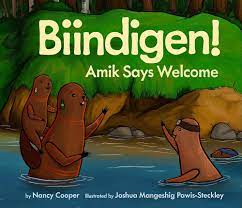Biindigen! Amik Says Welcome

Biindigen! Amik Says Welcome
While the beavers visit, two white-tailed deer come out of the forest to nibble on the poplar leaves.
“Miigwech,” says one deer to the beavers. “It’s easier for us to get to these leaves after you cut down the trees.”
“Excuse me, Waawaashkeshi,” Amik asks the deer. “Have you seen my little sister?”
“No,” Waawaashkeshi replies. “We’ve been busy foraging for buds and twigs.”
Beavers Amik and Nishiime are eagerly awaiting their cousins who are coming for a visit. Nishiime, the younger of the two, is feeling quite nervous. Once all of the visitors have arrived, Nishiime is nowhere to be found. A concerned Amik and her beaver relatives go searching, asking the animals that they meet if they have seen Nishiime. Each animal they encounter begins the conversation by thanking Amik for how the beavers make their lives easier. Just as the relatives are about to depart, Nishiime reappears. After observing their relatives help Amik in her search, Nishiime finally feels comfortable enough to talk to them. Soon, the relatives depart with the promise that Nishiime can visit them when she is older.
It is important to note that every culture has its own flavour of storytelling, with differences in rhythm, structure, and flow. As I am not familiar with the Chippewas of Rama’s storytelling traditions, I will be critiquing this book through a Western lens. This means that I may miss important markers in the tale or unknowingly critique elements that are integral to Chippewas of Rama stories.
The structure of this story is excellent. As Amik searches for her sister, the narrative has a predictable format that will help young listeners and readers absorb the story and predict what will happen next. Despite being a bit text-heavy for the preschool crowd, the story is easy to follow. Science-minded kids will enjoy learning about the multitude of ways that beavers impact their local ecology and make other animals’ lives easier. Unfortunately, the script frequently feels didactic, making the dialogue feel less than natural. The back matter includes English translations of the Anishinaabe words used in the story and shares the neat fact that each of Amik and Nishiime’s relatives came from a different Nation.
The text is in a clear font and has maximum contrast with the background, making it easy to read. There are a couple of instances where the book design plays with the font (making it larger to show excitement or aligning lines of text with the images they are describing), but, for the most part, it is organized in clumps of text. This is understandable considering the word count of the story, but it does mitigate engagement.
The copyright information does not list the media used to create the book’s illustrations. The artwork is likely mixed media, featuring watercolour and possibly ink. While the colour palette is dominated by browns, greens, and blues, considering the setting and main characters, this makes perfect sense. Most elements are outlined and feature good contrast, making the illustrations easy to decipher. The beavers and other animals feature light touches of pattern. These decorations add visual interest without overwhelming the viewer. Most spreads are full-bleed with a good amount of detail, giving young readers plenty to look at while enjoying the story. Nishiime hiding in each scene is a fun touch which is brought full-circle at the end when she shares that she has been watching the group the entire time. While it is not difficult to discern what the beavers are feeling, it would have been nice if the other animals had been a bit more expressive. They often felt more like pieces of scenery rather than characters in their own right. Unfortunately, this reinforced the didactic qualities of the text. It felt as if these animals were only there to serve a purpose rather than seamlessly woven into the story.
Biindigen! Amik Says Welcome is a sweet educational story about family and nature embedded in several Nations’ traditions.
Sadie Tucker is a children’s librarian at the Vancouver Public Library.
